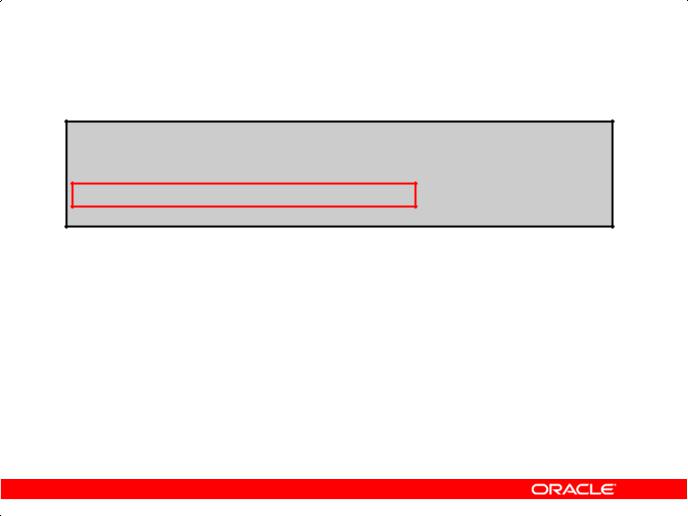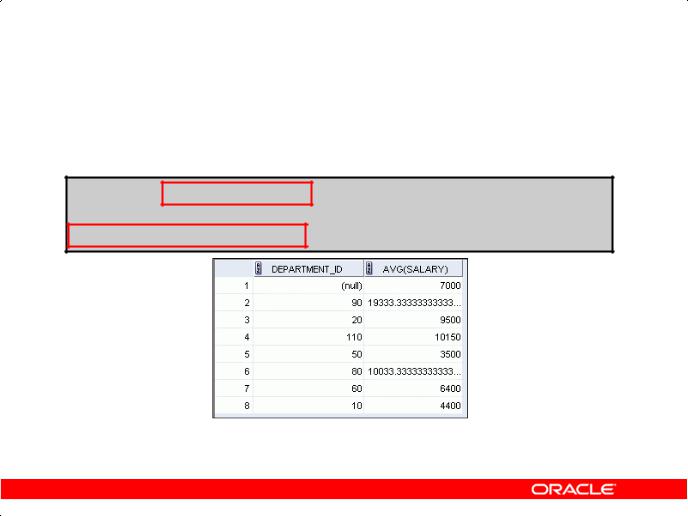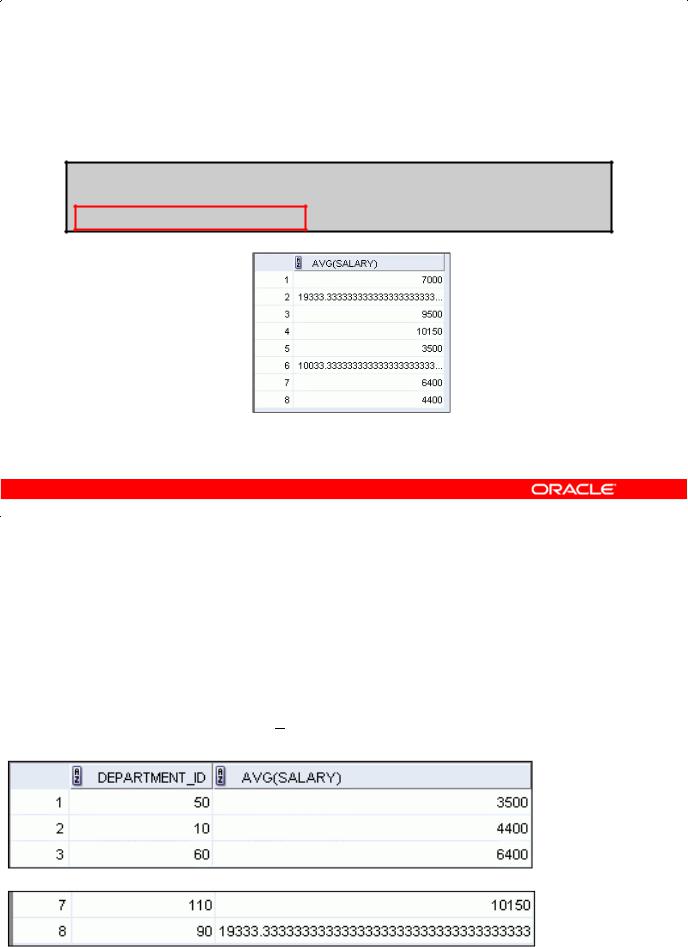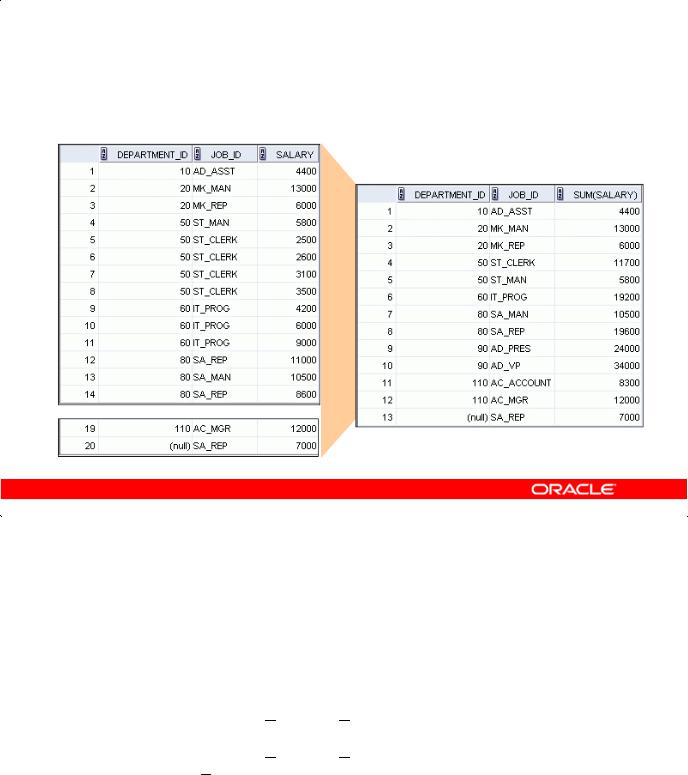
- •Preface
- •Introduction
- •Lesson Objectives
- •Lesson Agenda
- •Course Objectives
- •Course Agenda
- •Appendixes Used in the Course
- •Lesson Agenda
- •Oracle Database 11g: Focus Areas
- •Oracle Database 11g
- •Oracle Fusion Middleware
- •Oracle Enterprise Manager Grid Control 10g
- •Oracle BI Publisher
- •Lesson Agenda
- •Relational and Object Relational Database Management Systems
- •Data Storage on Different Media
- •Relational Database Concept
- •Definition of a Relational Database
- •Data Models
- •Entity Relationship Model
- •Relating Multiple Tables
- •Relational Database Terminology
- •Lesson Agenda
- •Using SQL to Query Your Database
- •SQL Statements
- •Development Environments for SQL
- •Lesson Agenda
- •The Human Resources (HR) Schema
- •Tables Used in the Course
- •Lesson Agenda
- •Oracle Database 11g Documentation
- •Additional Resources
- •Summary
- •Practice I: Overview
- •Objectives
- •Lesson Agenda
- •Capabilities of SQL SELECT Statements
- •Basic SELECT Statement
- •Selecting All Columns
- •Selecting Specific Columns
- •Writing SQL Statements
- •Column Heading Defaults
- •Lesson Agenda
- •Arithmetic Expressions
- •Using Arithmetic Operators
- •Operator Precedence
- •Defining a Null Value
- •Null Values in Arithmetic Expressions
- •Lesson Agenda
- •Defining a Column Alias
- •Using Column Aliases
- •Lesson Agenda
- •Concatenation Operator
- •Literal Character Strings
- •Using Literal Character Strings
- •Alternative Quote (q) Operator
- •Duplicate Rows
- •Lesson Agenda
- •Displaying the Table Structure
- •Using the DESCRIBE Command
- •Quiz
- •Summary
- •Practice 1: Overview
- •Objectives
- •Lesson Agenda
- •Limiting Rows Using a Selection
- •Limiting the Rows That Are Selected
- •Using the WHERE Clause
- •Character Strings and Dates
- •Comparison Operators
- •Using Comparison Operators
- •Range Conditions Using the BETWEEN Operator
- •Membership Condition Using the IN Operator
- •Pattern Matching Using the LIKE Operator
- •Combining Wildcard Characters
- •Using the NULL Conditions
- •Defining Conditions Using the Logical Operators
- •Using the AND Operator
- •Using the OR Operator
- •Using the NOT Operator
- •Lesson Agenda
- •Rules of Precedence
- •Lesson Agenda
- •Using the ORDER BY Clause
- •Sorting
- •Lesson Agenda
- •Substitution Variables
- •Using the Single-Ampersand Substitution Variable
- •Character and Date Values with Substitution Variables
- •Specifying Column Names, Expressions, and Text
- •Using the Double-Ampersand Substitution Variable
- •Lesson Agenda
- •Using the DEFINE Command
- •Using the VERIFY Command
- •Quiz
- •Summary
- •Practice 2: Overview
- •Objectives
- •Lesson Agenda
- •SQL Functions
- •Two Types of SQL Functions
- •Single-Row Functions
- •Lesson Agenda
- •Character Functions
- •Case-Conversion Functions
- •Using Case-Conversion Functions
- •Character-Manipulation Functions
- •Using the Character-Manipulation Functions
- •Lesson Agenda
- •Number Functions
- •Using the ROUND Function
- •Using the TRUNC Function
- •Using the MOD Function
- •Lesson Agenda
- •Working with Dates
- •RR Date Format
- •Using the SYSDATE Function
- •Arithmetic with Dates
- •Using Arithmetic Operators with Dates
- •Lesson Agenda
- •Date-Manipulation Functions
- •Using Date Functions
- •Using ROUND and TRUNC Functions with Dates
- •Quiz
- •Summary
- •Practice 3: Overview
- •Objectives
- •Lesson Agenda
- •Conversion Functions
- •Implicit Data Type Conversion
- •Explicit Data Type Conversion
- •Lesson Agenda
- •Using the TO_CHAR Function with Dates
- •Elements of the Date Format Model
- •Using the TO_CHAR Function with Dates
- •Using the TO_CHAR Function with Numbers
- •Using the TO_NUMBER and TO_DATE Functions
- •Using the TO_CHAR and TO_DATE Function with RR Date Format
- •Lesson Agenda
- •Nesting Functions
- •Lesson Agenda
- •General Functions
- •NVL Function
- •Using the NVL Function
- •Using the NVL2 Function
- •Using the NULLIF Function
- •Using the COALESCE Function
- •Lesson Agenda
- •Conditional Expressions
- •CASE Expression
- •Using the CASE Expression
- •DECODE Function
- •Using the DECODE Function
- •Quiz
- •Summary
- •Practice 4: Overview
- •Objectives
- •Lesson Agenda
- •What Are Group Functions?
- •Types of Group Functions
- •Group Functions: Syntax
- •Using the AVG and SUM Functions
- •Using the MIN and MAX Functions
- •Using the COUNT Function
- •Using the DISTINCT Keyword
- •Group Functions and Null Values
- •Lesson Agenda
- •Creating Groups of Data
- •Creating Groups of Data: GROUP BY Clause Syntax
- •Using the GROUP BY Clause
- •Grouping by More than One Column
- •Using the GROUP BY Clause on Multiple Columns
- •Illegal Queries Using Group Functions
- •Restricting Group Results
- •Restricting Group Results with the HAVING Clause
- •Using the HAVING Clause
- •Lesson Agenda
- •Nesting Group Functions
- •Quiz
- •Summary
- •Practice 5: Overview
- •Objectives
- •Lesson Agenda
- •Types of Joins
- •Joining Tables Using SQL:1999 Syntax
- •Qualifying Ambiguous Column Names
- •Lesson Agenda
- •Creating Natural Joins
- •Retrieving Records with Natural Joins
- •Creating Joins with the USING Clause
- •Joining Column Names
- •Retrieving Records with the USING Clause
- •Using Table Aliases with the USING Clause
- •Creating Joins with the ON Clause
- •Retrieving Records with the ON Clause
- •Creating Three-Way Joins with the ON Clause
- •Applying Additional Conditions to a Join
- •Lesson Agenda
- •Joining a Table to Itself
- •Self-Joins Using the ON Clause
- •Lesson Agenda
- •Nonequijoins
- •Retrieving Records with Nonequijoins
- •Lesson Agenda
- •INNER Versus OUTER Joins
- •LEFT OUTER JOIN
- •RIGHT OUTER JOIN
- •FULL OUTER JOIN
- •Lesson Agenda
- •Cartesian Products
- •Generating a Cartesian Product
- •Creating Cross Joins
- •Quiz
- •Summary
- •Practice 6: Overview
- •Objectives
- •Lesson Agenda
- •Using a Subquery to Solve a Problem
- •Subquery Syntax
- •Using a Subquery
- •Guidelines for Using Subqueries
- •Types of Subqueries
- •Lesson Agenda
- •Single-Row Subqueries
- •Executing Single-Row Subqueries
- •Using Group Functions in a Subquery
- •The HAVING Clause with Subqueries
- •What Is Wrong with This Statement?
- •No Rows Returned by the Inner Query
- •Lesson Agenda
- •Multiple-Row Subqueries
- •Lesson Agenda
- •Null Values in a Subquery
- •Quiz
- •Summary
- •Practice 7: Overview
- •Objectives
- •Lesson Agenda
- •Set Operators
- •Set Operator Guidelines
- •The Oracle Server and Set Operators
- •Lesson Agenda
- •Tables Used in This Lesson
- •Lesson Agenda
- •UNION Operator
- •Using the UNION Operator
- •UNION ALL Operator
- •Using the UNION ALL Operator
- •Lesson Agenda
- •INTERSECT Operator
- •Using the INTERSECT Operator
- •Lesson Agenda
- •MINUS Operator
- •Using the MINUS Operator
- •Lesson Agenda
- •Matching the SELECT Statements
- •Matching the SELECT Statement: Example
- •Lesson Agenda
- •Using the ORDER BY Clause in Set Operations
- •Quiz
- •Summary
- •Practice 8: Overview

Creating Groups of Data:
GROUP BY Clause Syntax
SELECT column, group_function(column) FROM table
[WHERE condition]
[GROUP BY group_by_expression]
[ORDER BY column];
You can divide rows in a table into smaller groups by using the
GROUP BY clause.
Copyright © 2009, Oracle. All rights reserved.
Creating Groups of Data: GROUP BY Clause Syntax |
Academy |
||
|
|
|
|
You can use the GROUP BY clause to divide the rows in a table into groups. You can then use the |
|||
group functions to return summary information for each group. |
|
||
In the syntax: |
|
specifies columns whose values determine the basis for |
|
group_by_expression |
|||
|
|
Oracle |
|
|
|
grouping rows |
|
Guidelines |
|
& |
|
• If you include a group function in SELECT clause,Onlyyou cannot select individual results as well, |
|||
unless the individual column appears in the GROUP BY clause. You receive an error message if |
|||
you fail to include the column list in the GROUP BY clause. |
|
||
• Using a WHERE clause, you can excludeUserows before dividing them into groups. |
|||
• You must include the columns in the GROUP BY clause. |
|
||
|
Internal |
|
|
• You cannot use a column alias in the GROUP BY clause. |
|
||
Oracle |
|
|
|
Oracle Database 11g: SQL Fundamentals I 5 - 14

Using the GROUP BY Clause
All columns in the SELECT list that are not in group functions must be in the GROUP BY clause.
SELECT department_id, AVG(salary)
FROM employees
GROUP BY department_id ;
Copyright © 2009, Oracle. All rights reserved.
Using the GROUP BY Clause |
Academy |
|
When using the GROUP BY clause, make sure that all columns in the SELECT list that are not group functions are included in the GROUP BY clause. The example in the slide displays the department number and the average salary for each department. He e is how this SELECT statement, containing
a GROUP BY clause, is evaluated: |
|
Only |
|
• The SELECT clause specifies the columns toOraclebe retrieved, as follows: |
|||
|
|
& |
|
|
- Department number column in the EMPLOYEES table |
||
|
department number,Internalso the AVG function that is applied to the salary column calculates the |
||
• |
- The average of all salaries in the group that you specified in the GROUP BY clause |
||
|
Use |
||
The FROM clause specifies the t bles that the database must access: the EMPLOYEES table |
|||
• |
The WHERE clause specifies the rows to be r trieved. Because there is no WHERE clause, all |
||
rows are retrieved by d fault.
• The GROUP BY clause specifies how the rows should be grouped. The rows are grouped by Oracleaverage sa ary for each department.
Oracle Database 11g: SQL Fundamentals I 5 - 15

Using the GROUP BY Clause
The GROUP BY column does not have to be in the SELECT list.
SELECT AVG(salary)
FROM employees
GROUP BY department_id ;
Copyright © 2009, Oracle. All rights reserved.
Using the GROUP BY Clause (continued) |
Academy |
|
|
The GROUP BY column does not have to be in the SELECT clause. For example, the SELECT |
|
|
Oracle |
statement in the slide displays the average salaries for each department without displaying the respective department numbers. Without the department numbers, however, the results do not look
meaningful. |
|
|
Only |
You can also use the group function in the |
|
||
ORDER BY clause: |
|||
SELECT |
& |
|
|
department_id, AVG(salary) |
|||
Internal |
|
|
|
FROM |
employees |
|
|
|
Use |
||
GROUP BY departme t id |
|
||
ORDER BY AVG(salary); |
|
|
|
Oracle |
|
|
|
… |
|
|
|
Oracle Database 11g: SQL Fundamentals I 5 - 16

Grouping by More than One Column
Add the salaries in the EMPLOYEES table for each job, grouped by department.
… |
|
Copyright © 2009, Oracle. All rights reserved. |
Academy |
Grouping by More than One Column |
Sometimes, you need to see results for groups within groups. The slide shows a report that displays the total salary that is paid to each job title in each department.
The EMPLOYEES table is grouped first by the department number, and then by the job title within
that grouping. For example, the four stock clerks in department 50 are grouped together, and a single |
|||
|
|
|
Oracle |
result (total salary) is produced for all stock clerks in the group. |
|||
The following SELECT statement returns &the result shown in the slide: |
|||
SELECT |
departme t id, job id,Onlysum(salary) |
||
FROM |
|
employees |
|
GROUP BY d partment id, job id |
|||
ORDER BY job id; |
Use |
||
|
|
|
|
|
Internal |
||
Oracle |
|
|
|
Oracle Database 11g: SQL Fundamentals I 5 - 17
